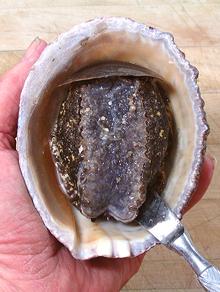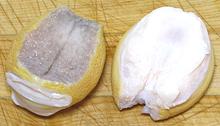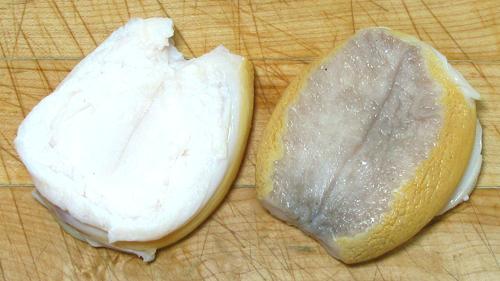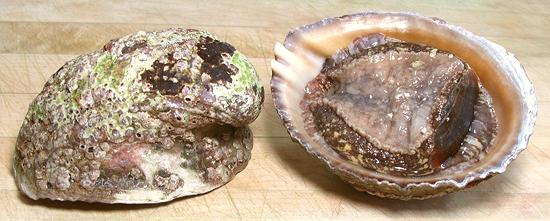
Scraping from shell

Removed from Shell

Cleaned & Scrubbed
In Chile, the most popular use for these mollusks is on top of an arranged salad, along with mayonnaise and Chilean salsa verde for dips. The second most popular is in a kind of soup-stew called Chupe de Locos. It is also used in Empenadas (stuffed pastries). The shells are used as ashtrays.
The photo specimens, purchased from a large Asian market in Los Angeles (San Gabriel) measured about 4-1/2 inches long and 3-1/2 inches wide, weighing about 13 ounces. Cost was 2016 US $19.99 per pound. Yield was 19%, giving a cost for edible meat of about $106 per pound. This was worthwhile only "For Science!", because the same Asian market carried frozen Locos meat for $16.99 per pound.
- Hold the Locos in your hand, and use a butter knife to scrape the foot loose from the shell. It is attached at the edge only, but all the way around, and most firmly at the head end (bottom in photo).
- Next remove the viscera from the foot. It's not much attached and scrapes off easily, except at the head end where a little trimming will be necessary. Remove anything that can be scraped off with a fingernail and any loose membranes.
- Pry off the operculum, a useless relic of some previous stage in the snail's evolution.
- Use a stiff brush and scrub the foot muscle vigorously to remove all the dark coloration. In particular, scrub the bottom surface of the foot very well, because it's covered with a stiff mucous that doesn't come off easily.
- Use your kitchen mallet to pound the foot muscle well, but not so hard it starts to break up. You can actually feel hard spots in the foot that need a little more pounding. In Chile they use a stout branch to pound them.
- You can prepare the foot muscles for eating immediately, or freeze them for use later.

Cleaned, Scrubbed and Pounded.
 [Pie de Burro; Concholepas concholepas of family Muricidae]
[Pie de Burro; Concholepas concholepas of family Muricidae]